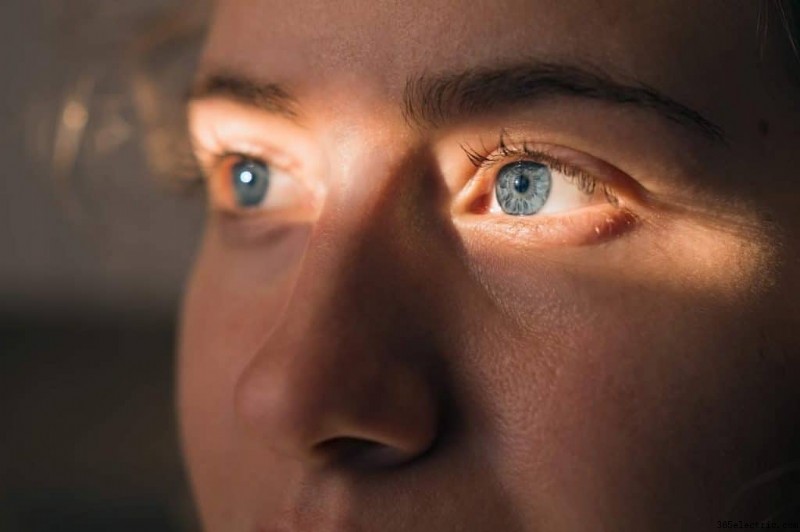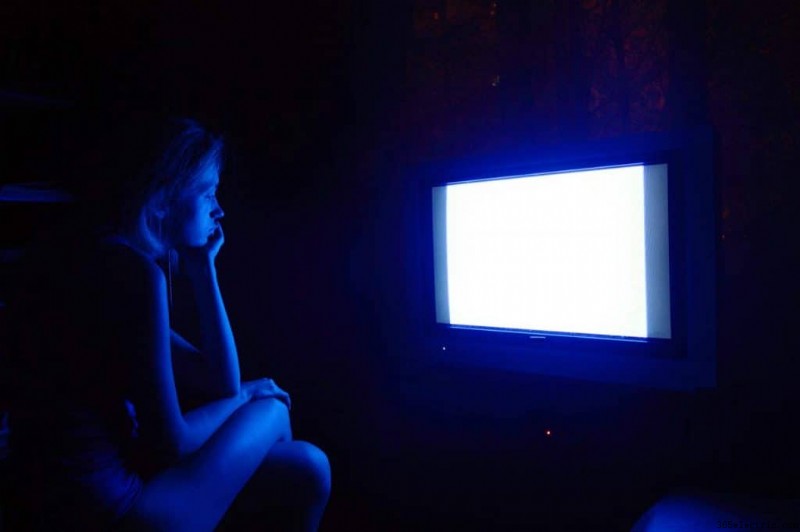TV vs. Proiettore:qual è il migliore per i tuoi occhi?
Le odierne tecnologie digitali e i servizi di streaming online offrono molte opportunità ai loro spettatori. Quando decidi di scegliere una TV o un proiettore per visualizzare i tuoi contenuti multimediali illimitati, quale pensi sia meglio per i tuoi occhi?
I venditori di video potrebbero evidenziare i vantaggi tecnici dei televisori rispetto ai proiettori, ma non parlare mai dei loro effetti sulla salute umana. Considerando l'impatto sugli occhi umani, dobbiamo ammettere, all'unanimità, che un proiettore è la scelta migliore.
Leggi anche:Quanto può essere lontano un proiettore dallo schermo?

Naturalmente, questa argomentazione ha anche diverse sfaccettature. È improbabile che guardare la TV un paio d'ore al giorno con le luci accese la sera danneggi gli occhi. Tuttavia, oggi raramente ci accontentiamo di qualche ora davanti alla TV, soprattutto nei fine settimana.
Che dire dei giovani di oggi, che spesso trascorrono giornate davanti allo schermo, giocando online o con i videogiochi?
Considerando tutti questi fattori, dobbiamo prendere una buona decisione sul tipo di sistema video da scegliere. In questo caso, i pochi svantaggi tecnici o di costo che possono avere i proiettori sono ampiamente controbilanciati dalla loro sicurezza per gli occhi umani.
Vantaggi e svantaggi – La TV vs. Dibattito sul proiettore esaminato
Quando si sceglie il proprio home theater, la cosa più logica è confrontare i prodotti offerti. Il confronto dipende dai criteri che hai stabilito. Ad esempio, se hai problemi agli occhi, la scelta tra TV e proiettore potrebbe essere più importante di quanto pensi.
Anche se non hai problemi agli occhi, dovresti essere consapevole che il tuo home theater può anche danneggiare la tua vista, proprio come lo schermo di un computer. Pertanto, la scelta giusta per la salute dei vostri occhi sarebbe quella meno dannosa tra i due dispositivi.
Confrontando TV e proiettori, dovremmo avvicinarci dal punto di vista della salute degli occhi.
I fan della TV evidenzieranno installazione e utilizzo complicati, requisiti di oscurità, qualità dell'immagine inferiore e prezzi elevati (il che è discutibile), tra i principali svantaggi dei proiettori.
Tuttavia, i proiettori hanno vantaggi abbastanza buoni che fanno sì che molte persone li scelgano per i loro home theater. L'elenco seguente fornisce diversi vantaggi principali dei proiettori rispetto ai televisori.
L'argomento di nostro particolare interesse sono i meriti relativi alla salute dell'occhio umano.
- Dimensioni dello schermo personalizzabili
- Immagini enormi
- Comfort per gli occhi
- Misura compatta
- Portabilità
- Valore
Comfort visivo della TV vs. Proiettore
Il comfort visivo offerto dai proiettori è strettamente legato alla sicurezza degli occhi, anche se anche le immagini di grandi dimensioni hanno a che fare con questo. Ciò che fa la differenza tra TV e proiettori è il tipo di luce che emettono.
I televisori riproducono le immagini tramite la luce diretta dai loro schermi, mentre i proiettori riflettono la luce sullo schermo davanti. Riflettere la luce è meno affaticante per gli occhi rispetto a quella diretta emessa dai TV LED e OLED, ad esempio. La luce emessa dallo schermo, invece, può essere pericolosa. (2)
Hai mai provato affaticamento degli occhi dopo aver fissato a lungo il tuo computer o lo schermo della TV? Milioni di persone in tutto il mondo hanno questa esperienza, ma pochissimi sono consapevoli di ciò che la causa. Interpretato tecnicamente, il segnale TV in ingresso passa attraverso un tubo a raggi catodici (CRT), che lo converte in un'immagine.
L'immagine viene quindi emessa, tramite elettroni e luce, attraverso lo schermo televisivo. Il problema deriva dalla luminosità della luce emessa perché l'occhio umano ha dei limiti su quanta luminosità può tollerare.
Vari ricercatori hanno studiato gli effetti della luce del diodo a emissione di luce (LED) sull'occhio umano nel corso degli anni.
La principale conclusione di questi studi è che la lunga esposizione degli occhi alle luci a LED, la tecnologia televisiva più utilizzata al giorno d'oggi, può causare danni irreparabili alla retina.
Le cellule della retina non sono rigenerative; pertanto, tale pregiudizio sarebbe irrevocabile. Solo la luminosità della luce non potrebbe causare danni così gravi. I ricercatori hanno scoperto che la causa è la radiazione nella luce HEV, nota anche come luce blu. (3)
Luce blu

La luce visibile ad alta energia (HEV) o luce blu è una luce ad alta frequenza e ad alta energia nella banda viola/blu da 400 a 450 nm nello spettro visibile. In natura, il sole emette luce blu. (4)
Anche le lampadine fluorescenti e a incandescenza, i computer, i laptop, la TV e gli schermi dei telefoni cellulari che utilizzano la tecnologia LED emettono elevate quantità di luce blu. Più corta è l'onda elettromagnetica della luce, più energia dannosa trasmette.
I raggi UV sono l'unica luce più potente con onde ad alta energia più corte rispetto alla luce blu. (5)
In 2019, France’s Agency for Food, Environmental and Occupational Health &Safety (ANSES) published a report proving the harmful effect of the blue LED light on the eye, which can cause impaired eyesight.
The report elaborates on the short-term effects on the retina, and long-term effects of age-related macular degeneration, inflicted by exposure to blue light. Blue light affects not only the vision but also other components of human health. Harvard Health Publishing alarms about the adverse effects of HEV light on sleep. (4)
The minimum result of prolonged exposure to blue light from the screen can be a digital eye strain.
Retinal Injury
The main danger for the human eye exposed to blue light comes from the electromagnetic radiation in wavelength between 400 and 450nm. The eye can perceive photopic luminous flux while the blue light emits radiometric radiance.
The difference in the spectrum of brightness is about 26 times higher, so the retina cannot stand it. In other words, photoreceptors in the eye absorb light with a higher brightness than its limit. The result is photochemical-induced retinal injury, which is irrecoverable. (4)
The most powerful emitter of blue light is the sun. Nevertheless, long-distance and the air reduce its volumes to harmless levels when it hits our eyes and skin. It is not the case with the LED screen of our TV or computer, however.
The direct emission of blue light causes eye and other health problems. Besides the retinal injury, The list below displays some additional risks and side effects of blue light exposure. (5)
- Digital eye strain
- Dry eyes
- Sore or irritated eyes
- Tired eyes
- Headaches
- Facial muscles fatigued by squinting
- Sleep problems
- Risk of hormone-related cancers
- Lower levels of leptin
- Metabolic changes, especially blood sugar
- Macular degeneration
Digital Eye Strain
Researchers have found that using digital devices, such as computers, cell phones, or TVs for long periods can cause digital eye strain. People, who stare at the screen for long, are prone to blink less often than usual.
Fewer blinks can lead to less moisture and more tension in the eyes. The digital eye strain involves different symptoms in different individuals, but it should be a signal lamp for possible retinal injury. (5)
You can see some of the symptoms in List 2 above.
Effect On Sleep

Various studies alarm that the prolonged exposure to blue light interrupts people’s sleep-wake cycle.
Light sensors in human eyes and skin discern the daylight, consisted of intense blue light waves, and the warmer tones in the red spectrum at the end of the day.
As a result, receptors release the sleep-indicating hormone melatonin when sunlight is going down. However, deceived by screen blue light in the evening, sensors do not release melatonin, which leads to disruptions in sleep. (5)
Sleeplessness may have some severe health consequences, shown in List 2 above.
Macular Degeneration
Age-related macular degeneration (AMD) refers to the damage of the back of the eye, called macula, due to advanced age. People above 50 usually suffer AMD and lose the ability to see the center of their field of vision.
Various researches on animals promoted the version that blue light most likely accelerates the process of macular degeneration. However, no clear pieces of evidence about such effect have been released so far. (5)
Nevertheless, uncertainty in science should never be soothing.
TV Vs. Projector – Concerns
When choosing between TV and Projector, eye health should be the number one consideration. The following primary concern for the eyes is, of course, blue light.
Knowing which device emits direct blue light and reflecting it (if there is any), the choice should not be so difficult. However, we can formulate several criteria regarding human eye health, according to which to compare and contrast the two devices to make the best choice.
The table below represents how TVs and projectors meet the eye health criteria.
| CRITERIA | PROJECTORS | TVs |
| Blue light Discharge | Virtually Blue Light Free | Strong Blue Light Emission |
| Light Source | Reflected Light | Emitting Direct Light |
| Screen Size | Easily Larger Than 80” | Common Size Under 70” |
| Smart Safety Features | Built-in | None |
The criteria above are based on their relation to eye health safety. The first two, blue light discharge and light source, compare the light emissions of the two devices.
The second two, screen size and intelligent safety features, represent the properties (if any) of projectors and TVs to prevent harmful light effects. These criteria are a perfect standpoint to decide which device to buy for home. They should have top priority, before the price or difficult installing because the health has no price.
Blue Light Discharge
Usage of blue light is the working principle of LED technologies. Therefore, TVs are an indisputable champion in this regard.
According to research held in the US, the average American spends over 4,5 hours in front of the LED, LCD, and other variations of TV, which emit detrimental amounts of blue light, especially at night time.
Projectors, on the other hand, produce far less concentrated amounts of blue light. Providing that the spectator does not stare directly at the light source, the damage to his eyes is minimal or none. (6)
Light Source
Generally, light sources are divided into two categories, according to their trajectory to the eyes – direct and indirect. Direct light is quite hard for the human eye, and when this is blue light, it is harmful.
TVs and other screen-based devices emit direct light. Projectors, on the contrary, use indirect light to reproduce images on the screen. Their reflected light is less intrusive to human vision and reduces eye strain and other harmful effects of prolonged viewing. (6)
The projector screen absorbs the initial flux of blue light and turns it into a harmless light stream.
Dimensioni dello schermo
Screen size is directly related to eye comfort. Projectors can easily create huge images due to the capability of their screens to be produced in sizes over 100”.
Larger images are more comfortable to view and reduce eye strain. Reading subtitles, for example, is much easier and does not require any eye effort. TVs have limitations in size, and in combination with direct light, they exhaust the eyes much more. (6)
Smart Safety Features
One of the most significant advantages of modern projectors over TV technologies is their built-in safety features against accidental eye injury.
So-called smart projectors have an eye protection option, which temporarily switches off the lens when an object is detected too close to the projector beam. This function automatically eliminates every possibility for prolonged exposure to direct light, even by chance.
It is a great advantage, especially if you have children running around. Even the latest TV models do not have such safety features. (6)
Safety Summary
To summarize, analyzes of TVs and projectors’ safety regarding eye health concludes that undisputedly, projectors are better for human eyes. They minimize the harmful effects of blue light and direct light while providing adjustable screen projection size. (6)
Projectors function on the principle of reflected light, which contributes significantly to eye comfort. Finally, yet importantly, modern projectors have intelligent safety features to avoid accidental eye injuries. With that being said, by investing in a projector for your home theater, you invest in your family’s health.
FAQ
How To Reduce Blue Light Exposure?
The best way to reduce blue light exposure is to minimize our screen addiction. However, the internet and smart technologies are already so deeply integrated into our daily routines that it is pretty unlikely to change our habits. Furthermore, people working on computers do not even have a choice.
Projectors, for example, provide an excellent option to reduce blue light exposure! Even if you have to work on a computer daytime, you can relax in the evenings, watching your favorite show or serial on the projector screen.
How Can I Protect My Eyes From TV?
Complete protection is impossible unless you use a projector. However, there are few steps you can take to mitigate the digital eye strain.
First, adjust the lighting to a comfortable for your eyes level. Then limit the screen time, take breaks, often ventilate your place. Choosing appropriate eyeglasses could also have a preventive effect on your eyes.
Where Should Light Be When Watching TV?
The right place for the light is in the area behind the TV set. This way, the light will emit outwards in a scattered manner, around the bright spot of your TV.
Placing the light somewhere else, especially in front of the screen, would be pretty inappropriate. Shining onto the screen would create irritating reflections on your TV screen, which can also cause eye strain. You also have to adjust the light intensity properly.
Can I Use Projector For Everyday TV Watching?
People usually associate watching TV with its watching on a TV screen. However, watching TV every day on the projector is a possible and reasonable action. We have already pointed out the health benefits of using a projector.
Daily projector use can add a better TV-watching experience on a higher screen and at a lower price. Except that some bulbs may run down faster, nothing else can happen to your projector.
Pensieri finali
To worry whether we use eye-safe video devices or not when LED technologies became a driving necessity of our intensive lives sounds a bit inappropriate.
Many people would wonder why they should spend time, money, and energy buying and installing an eye-safe projector at home while most of the day his family and he spent in front of the computer or cell phone display. However, everyone should know that a healthy lifestyle is worth it.
Watching TV on your projector for few hours in the evening may not have the desired absolute eye safety. However, this will be an excellent example for your children to appreciate their health and do their best to preserve it.
Sources
- Emily Clarke, “Advantages of Projector in Home Theatre Environment.” Medium, https://medium.com/@emilyclarkelondon/advantages-of-projector-in-home-theatre-environment-9ed9ca284d20 Assessed Apr 24, 2021
- Bryan Cavataro, “Projector or TV:Is It Even a Contest?” Gear Patrol, www.gearpatrol.com/tech/a119933/tvs-vs-projectors/ Assessed Apr 24, 2021
- PTI, “ LED Lights Can Damage Your Eyes:Study.” Gadgets Now, www.gadgetsnow.com/computing/led-lights-can-damage-your-eyes study/articleshow/20084961.cms Assessed Apr 24, 2021
- Wikipedia, “Biological Effects of High-Energy Visible Light.” Wikimedia Foundation, https://en.wikipedia.org/wiki/Biological_effects_of_high-energy_visible_light Assessed Apr 24, 2021
- Rebecca Stanborough, “What Is Blue Light, and How Does It Affect Our Eyes?” Healthline, www.healthline.com/health/what-is-blue-light. Assessed Apr 24, 2021
- Chris Davis, “Projector vs. TV:Consideration to Eye Health.” ViewSonic Library, www.viewsonic.com/library/entertainment/projector-vs-tv-consideration-to-eye-health/ Assessed Apr 25, 2021
